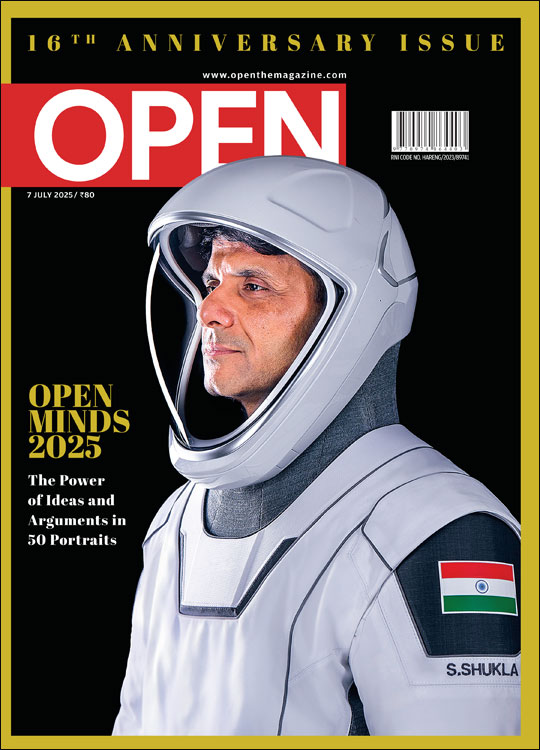Beauty of the Beast
A ringside view of lions in their natural habitat at the Maasai Mara is a privilege that borders on the profound
 Aditya Iyer
Aditya Iyer
 Aditya Iyer
Aditya Iyer
 |
21 Dec, 2017
|
21 Dec, 2017
/wp-content/uploads/2017/12/Beautybeast1.jpg)
The zebra is dead
White, black and a gush of red
Under her warm flesh, over her snout frozen cold
Lurk shadows of cats, loom ghosts of gold
SWEARING UNDER his breath, Daniel Korinko, a big cat tracker of some repute, sweeps the plains with his naked eyes. Returning under the tarpaulin roof, his shoeless feet still on the driver’s seat, Korinko fetches his binoculars from the rattling dashboard without shifting his focus from the grasslands. He glasses the vast stretch of acacias to his left, his thin lips in a pout. “Simba,” he whispers in Swahili, breathily, mostly to himself. “M’uzuru, m’uzuru.” Lion. Good, good. While tying his shoelaces, gear-shaft still bobbing with anticipation in neutral, a smile crosses his face for the first time on this crisp, Kenyan dawn.
“Lion, male. He and his pride had crossed over into the Serengeti a few months back,” Korinko says. “Looks like we’re in luck for he has returned and is waiting for us near the escarpment. Shall we go?” And just like that, he lunges the Pinzgauer, an Austrian army four-by-four, off-road into the bush and we bounce over rocks and ant-hills and termite mounds, and all around us, zebras and elands and impalas swish their tails and clomp their hooves, disappearing like ghouls into reeds of yellow and brown.
“How did you spot him?” I ask while yo-yoing about in the passenger seat, with still no sight of the beast some 10 minutes into this rumbling journey. “He stood up, on his front paws, and sat down again,” replies Korinko. That move, caught by his peripheral vision from a moving car no less, was enough, evidently. “Look, he has turned his head and is now looking at us,” he whispers, words that make photojournalist Rohit Chawla, seated directly behind the driver’s seat, reach for his powerful zoom lens and aim his camera in the general direction of Korinko’s index finger. In about a minute, Chawla shakes his head. Nothing. Korinko smiles. So we bide our time, staring at a desolate terrain littered with the dead—ribcage of a topi here, a wildebeest skull there, zebra jaws everywhere. Up above in the immaculate sky, great gatherings of vultures swirl about, gliding wings spiralling towards the freshly fallen.
We’re in the north-western edge of the Maasai Mara reserve, in a section of the Great Rift Valley known as the Mara Triangle, named so due to three perfect borders—the Oloololo Escarpment to the west, the Mara River to the east and the ruler-straight Kenya- Tanzania border to the south. A month prior to our visit around mid-July, this was paradise for the migrating wildebeests, a birthing plain of sorts, with an average of 8,000 calves born a day to those trapped in the lush grasslands between the escarpment and the river. In the first week of August, this becomes paradise for big cats, the grass swaying at just the right height to remain hidden and pick off the herbivores (especially newborn wildebeests, abandoned by mothers who often associate their calves with labour pain) at will. Today, a late August morning, this Triangle is paradise for trackers with senses as keen as Korinko’s. In a landscape flattened to a neat carpet by the migrating millions, Korinko can sense the slightest movement around a drinking hole from, as he puts it, “lots many miles away”. From less than 10 yards away, so can we.
As the Pinzgauer putters to a halt, it dawns upon everyone (bar Korinko) that there is a massive male lion sprawled, rather expansively in the bed of grass, about 30 feet away from us. Apart from the wind rustling gloriously through his dark, rich mane and the expanding-contracting belly (and what a belly it is), the lion is completely still, seated with the largesse of a forgotten bronze god, noble like the Sphinx. Our vehicle had approached him in a direction perpendicular to his outstretched frame but not once did he tilt his grand head, despite being close enough to smell the vehicle’s exhaust. “I’m going to go just a little closer,” whispers Korinko, lurching the four-by-four ahead. “If anyone is not comfortable, stay in your seat and look in the other direction.” He pulls up three yards, or 10 feet, from the lion’s thunder-sized paws, and in a vehicle with no doors and windows, you can’t help but feel a little naked.
Korinko kills the engine and there’s an eerie, guttural strength to the silent Mara air. Now, we’re close enough to hear the beast breathe. Now, we’re close enough to look him in his eyes. Correction: close enough for him to look us in our eyes. He surveys each passenger in this intrusive contraption one by one and there’s no doubting when his gaze is on you because when he locks his pupils made of molten gold with yours, he consumes you whole and scans your soul and spits you out. When he first focussed on me, I found myself desperately wanting to take a step back. Over the next three minutes or so, neither of us blinked and I felt my stomach churn and jump like I were on a rollercoaster ride and I made a mental note of just how firm my grip had become on the vehicle’s side railing. The whole exercise had the paranormal feel of a solar eclipse.
The Maasai Mara has a mesmeric effect on wildlife enthusiasts. I had marvelled, slackjawed, as we passed through an ocean of Cape buffaloes, had felt the morbid rush of being charged at by a bull elephant and had even sat on the banks of a river brimming with burping hippos and yawning crocs. But to say this moment—locked in a stare with a lion in his natural habitat, from less than 10 feet away—was mesmerising would be an understatement. It was, and shall forever be, a privilege that borders on the profound. Greater men have fallen for the charm of the Panthera Leo and I begin to understand just why Ernest Hemingway would make his South American protagonist in a story set in Cuba dream feverishly of lions roaming these lands.
The hypnosis breaks when we hear a thud in the distance, about 50 yards to the south of the lion’s immobile tail. Instinctively, Korinko fires up the engine and drives towards the commotion and what we witness is breathtaking. A lioness is dragging, with her canines wrapped around the jugular, a zebra towards a termite mound littered with cubs. Life still flickers in the zebra’s epileptic limbs. But death can be seen in her large black pupils and soon the agitation ends. From the reeds three more majestic lionesses appear in measured strides and in one swift motion they slit open the zebra’s stomach and the entrails spill out. We can hear the cubs chew through the warm organs and when a delighted Korinko, in a voice thinner than a whisper, says “the entire pride is here,” a lioness with a blood-soaked chin looks up from her meal and snarls at him.
Time is but an illusion in the African wild. Before we know it, dawn has cracked through the splintered sky and silhouettes of elephants, like forgotten ghosts, appear against the rising run
There are six lionesses in all, and eight cubs, spread over three zebra carcasses in different stages of consumption. The alpha male must surely have had his proverbial lion’s share of the other zebras as well, which explains the size of his heaving stomach. Yet, as he now arrives with a growl to claim his portion of the latest kill, the fine ladies with bloody whiskers turn subservient on cue and walk a small distance away. The lion stands over the zebra and lazily looks at every member of his pride. Then he locks his mouth around the zebra’s limp neck and hauls her, effortlessly, some 50 yards away, back to whence he came. Ownership secured, he plonks himself on his stomach, besides the kill, hindquarter pointing towards his wives and children. Within minutes, he rests his magnificent mane on his paws and falls asleep.
“That’s why they call him mfalme simba, the king of the jungle,” says Korinko. The pride doesn’t doubt it. They form a single file and make their way, along the shoulder of a dry ravine, to an off-shoot of the Mara. Together, they dip in their sublime golden faces and their lapping tongues rinse away all evidence of violence.
IN THE TRIBAL village of Talek, nestled on the border of the reserve’s eastern front, the Maasai people hum us a welcome with their terrific throats. The sound is reminiscent of a cloudburst. They wear flaming red shawls, splendid against their ink black skin. We’re here in Talek on the invitation of the Kenyan Tourism Board to see how the Maasai tribe lives in the 21st century. But I am more interested in their age-old conflict with lions.
The Maasai people are nomadic by nature, goatherds by profession. But they also have a fierce reputation for being lion-killers. Legend has it that a Maasai man once came of age the day he speared a lion and returned with the animal’s heart. He was then given the lion’s mane as his crown, circumcised and married off to the daughters of several chieftains—in that order. Today, thanks to the Kenyan government’s keen understanding of conservation, the Maasai’s manhood ceremony begins and ends with his circumcision. “And marrying many, many of women, don’t forget,” says Kurein M’taaty, our resident interpreter, chuckling. “My father and his brother no kill lions. But they have 19 wives (between them).”
Still, illicit lion-slaying remains rampant around Maasai villages. “I know people who have kill lions. Self defence,” he says. “One is my cousin.” We’re standing outside M’taaty’s hamlet and he points a long finger towards a row of acacia trees, the informal border of Talek and the national reserve. “One of my nephew was herding goats over there when he saw lion. He scream and climb tree. We come running from village and my cousin throw spear. He miss lion. He throw my spear and it hit lion. In neck.” The incident took place as recently as three years ago. But the story doesn’t end there.
To help the boy (and retrieve their beloved spears), M’taaty and his cousin galloped, armed with daggers, to the far side of the patch where the lion lay. “I remove spear from lion when he throw big paw at me,” he says, lifting his tunic and exposing ugly evidence of the attack. On his left thigh, between his groin and knee, lie two, uneven cleaves, void of any flesh. “Uff, uff. Very scary. But after that, he fall and dead.” Satisfied with his narration, M’taaty struts the walk of a warrior into his hamlet and says, “Come, I show you dead lion.” The violent realities of the African bush—it comes at you from all sides.
The settlement is perfectly circular, surrounded by a fence made of thorns and wood. Inside, the two semi-circles hold 10 and 9 huts each. “This huts is my father’s,” M’taaty says, pointing right. The ones of the left, then, are his uncle’s. The 19 wives, one in each hut, M’taaty says, produced 96 children between them. I see many of them—M’taaty’s brothers and sisters, nieces and nephews—in the central patch. At night, this is where they safekeep their goats. Now, in the afternoon, it is filled with young boys and girls, rolling in the mud. The older boys are smoking cheroots by their huts.
M’taaty ushers me into his mother’s hut. It is built, like all the others, of acacia branches and cow dung. The room is dark as the night, save for a single shaft of light that pours in from a pin hole on the far wall. Beds made of sheepskin, large and small, flank the beam of the light. “Father spend different night with different wife. When he sleep in this hut, he sleep on this bed,” he says, pointing at the bigger one. From under it, he pulls out a rolled carpet and unfurls it. It is dusty and has the texture of sandpaper. “When father here, mother cover bed with this. It is skin of same lion my cousin kill.”
Not long after we leave Talek do we run into a herd of restless Cape buffaloes. There are about 30 on one shoulder of a ravine, all snorting mad, horns and helmets pointed in a specific direction across the riverbed. They can sense danger and danger there is. From our vantage point, we can see a coalition of three young, ostracised lions lying in wait behind a bush. “Young and stupid,” says Korinko. “They’ll learn over time that even lions don’t mess with the buffalo.”
The learning unfolds instantly. From our ringside seat, we can see what the lions can’t. The herd, stomping and snorting, keep the lions’ collective gaze on them even as two buffaloes break pack and cut across the riverbed. Now, they can see the lions behind the shrub. Now, they blindside the exposed cats with a charge. Startled, the young males dig their claws into the earth to keep themselves from falling over the edge. Just as they regain their balance, the buffaloes charge again and the ambush is complete. The lions synchronise their leaps into the dry river and scram into the wilderness.
Korinko sees the dark humour in the drama and slaps his palms together. In and around the Maasai village of Talek, evidently, the lions never win.
DARKNESS IS NO place to hide from the theatre that is the African wild. Shortly after I fall asleep to the sounds of tree frogs and crickets, there’s a knock on the door of my lodge. Rat-tat- tat. It is one of the assistants of the lodge, who had spent the evening enthralling me with his several run-ins with mambas. “Big boys don’t sleep at night,” he says, laughing hysterically at my alarmed state. “Come, I take you to the river. There is plenty of action there at this time of night.” Any human movement is, by law, strictly prohibited in the reserve after 7 pm. But he insists that, as a local, he has a permit. Still, the road to the Mara at 1am is fraught with peril. Elephants, buffalos and big cats, of course, coupled with the fear of being mistaken for poachers and shot at by an anti-poaching squad.
Five minutes on, we’re in a Jeep and the assistant, who we shall call B’wana (Swahili for friend), is clapping his hands over the wheel, driving down a brown road that gleams purple at night. I would like to say I put on a brave face, but B’wana must’ve noticed the cold sweat trickling down my forehead or even heard my heart crashing against my ribcage. Thirty excruciating minutes later, we pull over by a security booth on the bank of the Mara and death is all around us, like a sticky sauce.
“Wildebeests, killed by crocodiles during the river-crossing a month ago,” B’wana says, noticing that I have covered my nose in the collar of my jacket. “The smell never goes away, but you will get used to it.” We walk to the booth, its porch decorated with wildebeest skulls, and under a naked bulb, introductions are made with the officer on his graveyard shift, B’wana’s brother. “I’m glad you’re here,’ says the brother, offering a torch for a handshake. “Come, come, come, let’s step out. There’s plenty to see.” He was putting it mildly, for once we stepped out, barely 10 feet from the back of the booth to the bank of the Mara, the river was exploding with activity. Africa was the stage and the actors of the night were life and the hooded face of death.
Washed ashore, amidst a spread of bones on our side of the bank, is the body of a relatively fresh wildebeest. The vultures have claimed it but are in a spread-feathered tussle with a group of wet and shivering hyenas. We strike eyeshine with our torchlight and the sniggering mammals dazzle like demons in the dark. The battle of the scavengers, however, is put to shame by the bedlam erupting from the far bank. This is a dispute for the river itself as crocodiles, anchored in fear to the mud, hiss and slap their Jurassic tails against one another when hippos (which we can’t see but sure can hear) surface to shoot jets of steam from their nostrils.
Time is but an illusion in the African wild. Before we know it, dawn has cracked through the splintered sky and silhouettes of elephants, like forgotten ghosts, appear against the rising run. As they thunder down the valley to cross the river, the Mara is momentarily theirs. The crocs slink away downstream while the agitated hippos grunt and groan their way against the current. Even the hyenas on the near bank have disappeared into the breaking day. Now, without a common foe, the vultures turn on each other, flapping and squawking by the bones, each devising cunning methods to peck away at the final smear of wildebeest flesh.

/wp-content/uploads/2025/06/Cover-OpenMinds2025.jpg)













More Columns
Armed with ILO data, India will seek inclusion of social security in FTAs Rajeev Deshpande
Elon Musk Returns to Rebellion Mode Against Trump Open
Without govt aid, Musk will have to head back home to South Africa: Trump Open